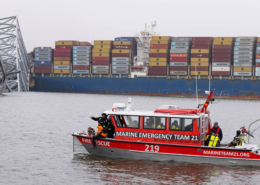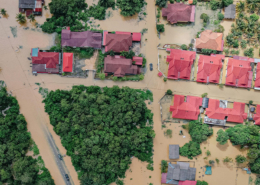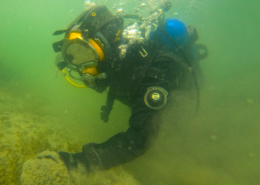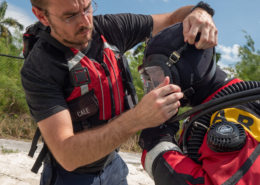Victim Care for Ice Rescue Operations
by: Bo Tibbetts
Professional surface ice rescue technicians must have an understanding of victim physiology when attempting to rescue an individual that is immersed in freezing water.
There are several factors that the victim in an ice rescue may experience; these include heat loss mechanisms, hypothermia, and cold stress. Heat loss can happen in five distinct manners. The first is conduction, which is defined as heat loss through a cold, solid material a person is in direct contact with and body heat is transferred from the body to the cold object.
The second manner of heat loss that an ice rescue victim will experience is convection, which is the transfer of heat from one place to another by the movement of liquids. As a person continues to make movements in frigid water, they will lose body heat at a steady rate through the process of convection. Body heat is also lost through evaporation, which happens when water or sweat on the surface of the skin turns into water vapor. When water, including sweat, evaporates, it cools the adjacent body surface. Evaporation is a very efficient body cooling mechanism.
The next heat loss mechanism is by means of radiation, which is the direct heat loss from the body to its surroundings. More specifically, it’s infrared radiation. Heat loss through radiation will occur when you don’t have the proper clothing for cold environments. Minimize heat loss through radiation by wearing the proper insulated protective gear.
The final manner of heat loss is by means of respiration, similar to evaporative cooling. Breathing brings freezing air into your lungs and your body warms the air. Through exhalation, the body releases the warmed air into the surrounding environment. Respiration is initiated internally and finalized externally as with evaporative heat loss.
Hypothermia In Ice Rescues
Any form of heat loss that an ice rescue victim experiences can precipitate hypothermia. Hypothermia is defined as a body core temperature below 35.0 °C (95.0 °F). Symptoms depend on the core temperature. In mild hypothermia, there is shivering and mental confusion. Most of us know that water leaches heat away from the body twenty-five times faster than ambient air of the same temperature. As a person moves about in the water, heat is then lost through convection. The body cannot regenerate heat fast enough to replenish the body’s rapid heat loss and temperature loss will occur. The victim’s metabolic rate, the clothing they are wearing, and their breathing rate will determine how long they can survive and whether it will be a rescue or a recovery operation.
Breathing is a key factor for both the immersed victim and the rescuer alike. It has been determined respiration is a heat loss mechanism. It is also the key to the formation of carbonic acid in the blood stream. Through rapid and excessive breathing, CO2 levels increase, which increases carbonic acid levels in the blood stream, causing cramps and loss of muscle function to the body’s extremities.
The USCG Cold Water Boot Camp states you have one minute to get your breathing under control. Upon getting your breathing under control, you have ten minutes for meaningful movement. After ten minutes, the body’s motor functions are depleted and additional functions continue in a downward spiral. At this point, the victim may be experiencing severe hypothermia, massive vasoconstriction, and loss of cognitive functions. Time is of the essence.
The victim has now been immersed in 33° water for more than ten minutes and some pertinent issues must be considered with respect to the care of the victim. Water immersion factors to be considered: Fresh water exerts .432 lbs. per foot, approximately ½ lb. per foot, of pressure on the victim’s body. So, let’s say the lower extremities of the victim are immersed in 4 feet of water. This depth of water exerts roughly 2 pounds of pressure on the lower extremities of the body. The body is already fighting hypothermia by pushing the blood to the heart for better efficiency in an effort to stay alive. This effect is then compounded as water pressure on the lower region of the body shunts blood away from the legs to the core. What would happen if the victim was extracted from the ice vertically? The blood would drop back to the lower regions of the body. A massive drop of blood, which in turn puts an incredible amount of stress on the heart. The victim should be extracted in a horizontal position so as to relieve pressure on the already fragile heart.
Many training agencies advocate simply going out and pulling the victim out of the ice and loading them on an inflatable boat. If this method of rescue is used, it will more than likely cause immediate harm, possibly death of the victim. Using devices such as the Ice Rescue System’s rapid transport sled will provide a platform to keep the victim in a horizontal position as they are being extracted from the ice.
Ice Rescues Require a Delicate Touch
We are at a pivotal point in the rescue. The body of the victim is now in a state of hypothermia. What precautions do we need to take to ensure no further injury to the victim is incurred? The answer to this question is to be GENTLE, very GENTLE, and even more GENTLE. Some professional rescue technicians handle their rescued victims with the same kind of care they give an animal being rescued. More harm is done to the victim than at any other time in the rescue process during extrication from the hole as they are being hauled to shore. This period of time is critical to the overall success of the rescue. Again, this is one more reason to utilize the rapid transport sled by Ice Rescue Systems. The ice is not hockey rink ice; it is a mass of hard, jagged, and clumpy ice, which may be very sharp.
Knowing the victim is in a state of severe hypothermia and is very sensitive to any form mishandling, a condition exacerbated by sudden, jerky movements is ventricular fibrillation. Studies have shown that with just the slightest jostling of a hypothermic patient their heart could go into Vfib. Again, this is dependent on how carefully the patient is handled. When a patient is in Vfib, they must receive defibrillation to return the heart to its normal operation.
Successful rescue is not just about extricating the victim from the ice but rather caring for them until they can get advanced life support. Remember, in order to do the job right, you must have the right training and the right equipment!


 Photo By: Defense Visual Information Distribution Service
Photo By: Defense Visual Information Distribution Service


 Y. ZIN
Y. ZIN


Skriv en kommentar
Vil du deltage i diskussionen ?Du er velkommen til at bidrage !